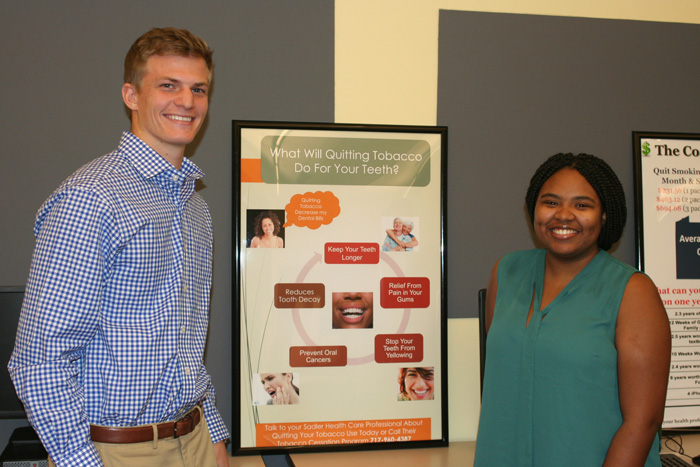Research Reaches Into the Community

Danny Sheppard '17 and Khadeeja McSeed '17 with one of the informational posters now hanging in the Sadler Health Center in downtown Carlisle.
Students partner with local health center to conduct smoking research
by Tony Moore
Dickinson students recently got to do some research that could make an impact far beyond their grades. Working with Professor of Psychology Marie Helweg-Larsen, 15 students in the Senior Seminar in Health Studies took an interdisciplinary view of smoking to help explain complex tobacco research.
The intended audiences? Both health professionals and smokers of low socioeconomic status (SES).
Headlong into research
Students first dived into literature on tobacco use, focusing on the challenges in smoking cessation among low SES smokers. They then created a patient survey on tobacco use. The goal was to use the survey in collaboration with Carlisle’s Sadler Health Center—a facility that provides various health and dental services, regardless of the patient’s ability to pay—so doctors there might better understand their patients’ smoking and quitting attitudes and habits.
“Rather than simply conducting a survey and analyzing the results in a term paper, the students went many extra miles to detail the complexities of tobacco addiction and offer practical recommendations for ways local organizations can help people quit,” says Becca Raley ‘94, executive director for Carlisle's Partnership for Better Health, who initially helped link students with Sadler. “The students’ findings offered a sobering reality of just how common smoking still is in our community and how a majority of smokers would like to quit.”
Sadler helped students focus the survey on areas of greatest need for their patient population and then distributed the survey to patients in the dental clinic, medical clinic and smoking cessation program. Students analyzed the subsequent survey data through three lenses, all focused on barriers to quitting: 1) smokers’ health literacy, 2) motivation and 3) addiction.
Community connection
In addition to communicating the research and survey results to health professionals, the students also communicated their smoking knowledge directly to the patients. Seven teams of students researched topics such as secondhand smoke, how to quit, benefits of quitting, the cumulative cost of smoking, dental health and e-cigarettes and worked to effectively communicate this information on posters now on display on the walls of Sadler’s examining and waiting rooms.
“One major benefit of the project is that students are getting to use their skills in reading and summarizing literature and communicating what they’ve learned in a way that's appropriate to either the Sadler clients or to the Sadler health professionals,” says Helweg-Larsen, who has studied the issue of tobacco use from many angles. “The class is really focused on career skills and skills that will be beneficial to students regardless of what their career choices are. They’re learning to do the kinds of things that are highly valuable once they have left Dickinson.”
Students—coming from such diverse majors as neuroscience, psychology, biology, Africana studies and sociology—presented their posters and research findings to Sadler staff and physicians, in addition to staff from Partnership for Better Health, the health studies program and academic affairs.
“It's the essence of a Dickinson education—the interdisciplinarity of working together with students of different disciplines at a more advanced level,” says Helweg-Larsen. “It's also about making an education useful and strengthening the bonds and contributions Dickinson can make in the community.”
Learn More
Published January 9, 2017